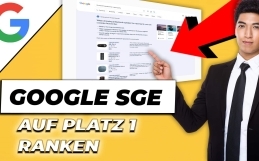eBay SEO – Understanding Search Algorithm Cassini
In a nutshell…
- Since 2013, eBay has been using the “Cassini ” search algorithm, which ranks offers according to their relevance.
- Relevance is determined by product-buyer interaction, a metric that takes into account several factors – the most important of which is the number of sales.
- In addition to relevance, specific keywords must be stored in the offer for sufficient visibility of an offer.
An auction platform becomes a marketplace
Originally launched as an auction platform, eBay has now largely mutated into a marketplace with fixed-price offers. Nowadays, more than 80% of all bids are tendered at fixed prices. And the trend is upward. While in the early days of the Internet it may have been exciting to bid on items and feverishly watch an auction, online shoppers currently prefer speed, security and convenience. You want a product delivered at a specific time with as little effort as possible. The market has changed radically.
The former #1 in online shopping also takes this into account and has been adapting to the changing market needs for quite some time. While Amazon is currently ahead in terms of innovation, eBay is still the second largest player in the market with a capitalization of several billion dollars. Accordingly, eBay is an indispensable sales market for the retail industry.
What does eBay actually want?
Like any retailer (or marketplace), eBay is primarily interested in maximizing its sales. eBay generates most of this revenue through seller fees, which are charged for each sale. So the more products that are turned over via the platform, the greater the overall profit for eBay.
It is therefore not surprising that eBay is doing everything it can to make the buying experience for platform visitors as purposeful as possible. Customers should buy products they find on eBay. eBay subordinates everything to this mantra and therefore tries to display products with the highest purchase probability for certain search queries.
Until 2013, eBay’s internal search algorithm “Voyager” was in use, where the primary goal was to cram as many relevant keywords as possible into the product title. Those days are over. For several years now, “Cassini” has been in charge. With the (now not so) new search algorithm, eBay wants to bring those products to the front of the ranking that have the greatest likelihood of purchase for a given search query. Cassini is taking dealers to task more than ever. This is because, in contrast to Voyager, many more factors are now relevant for the ranking.
How the “Cassini” search algorithm works
There are as many myths surrounding the Cassini search algorithm as there are about the Coca-Cola recipe. Alright – not quite that many, because from the information published by eBay itself and from try and error over the last few years, certain best practices have emerged that provide some insight into how the algorithm works.
Based on the goal of maximizing the probability of purchase, Cassini tries to sort all offers according to relevance. An offer is relevant whenever the system detects a product-buyer interaction . The biggest indication of a well-placed offer is high sales figures, but by no means the only one. Here is an overview of the influencing variables:
- High sales figures
- Click Through Rate (CTR)
- Number of observers
- Sell Through Rate (STR)
- Good seller ratings
- Good product reviews
Product-buyer interactions explained
The Click Through Rate (CTR) is the ratio between impressions and clicks on the offer on the search results page. In the eBay context, impressions mean the appearance of an offer on the search overview page – regardless of whether the user has “scrolled down” to the respective product listing. All visible offers on the search overview page are immediately recorded as impressions after a search has run. By default, 50 results are shown on the first page. If a customer then clicks on an impression, his action is positively evaluated by Cassini.
Sell Through Rate (STR) is another term for conversion rate. The count begins with a visit to a product detail page and concludes with a sale. The higher the conversion rate, the more relevant Cassini classifies the offer.
While seller ratings have always been an integral part of the eBay platform, there was no way to submit product reviews until a few years ago. In online retailing, product reviews are one of the most important factors in purchasing decisions, and so eBay recently decided to jump on the bandwagon after all. While this feature is far from being used in the same quantity as Amazon, it still offers massive advantages for those who know how to use it. Cassini can’t resist a positive product review either.
In addition to the specific relevance measurement by influencing variables above, Cassini also tests the pure probability of positive interactions. Thus, a positive sales history as well as extensive services have a positive influence on the relevance rating. More about this in part 2 of the article on eBay SEO (to come).
Relevance vs. visibility
Product-buyer interaction is an important metric when it comes to ranking. But what if a product is not found at all? Because what is not found has no chance to convert. It is therefore important to optimize the visibility of offers in addition to relevance. Only then can products be perceived by the customer and subjected to the relevance test.
Specifically, the goal is to show up on the search results page for certain keywords. For this, Cassini must find the search term in a similar form as a keyword in our article data. The more exactly our keyword matches the search term, the more relevant it will be ranked. Keywords can be stored in 3 ways. Not every path is equally weighted. More about eBay SEO.
However, too much visibility can be a disadvantage. If a product is found for extremely general (or even wrong!) keywords, customers may consider the offer uninteresting (related to their search query) and leave it to the left. The result would be low product-buyer interaction. Cassini would immediately register this and catapult the product down the ranking. It is therefore advisable to store the keywords as specifically as necessary so that the product remains relevant – but is still found for the common search terms. SEO optimization on eBay is always a trade-off between visibility and relevance.
Conclusion
It’s not rocket science to get ahead on eBay. Once you have understood the basic principle of eBay’s search algorithm Cassini, you can derive a number of optimization measures from it. All measures ultimately relate to either visibility or relevance.
In Part 2 on eBay SEO, we’ll introduce you to 10 concrete methods that can help you achieve big ranking improvements in a short amount of time. These methods have been proven in practice since Cassinis’s appearance and are used by leading eBay powersellers. Until then!



















